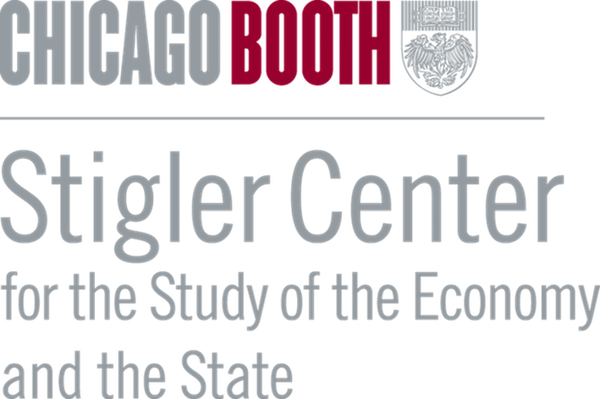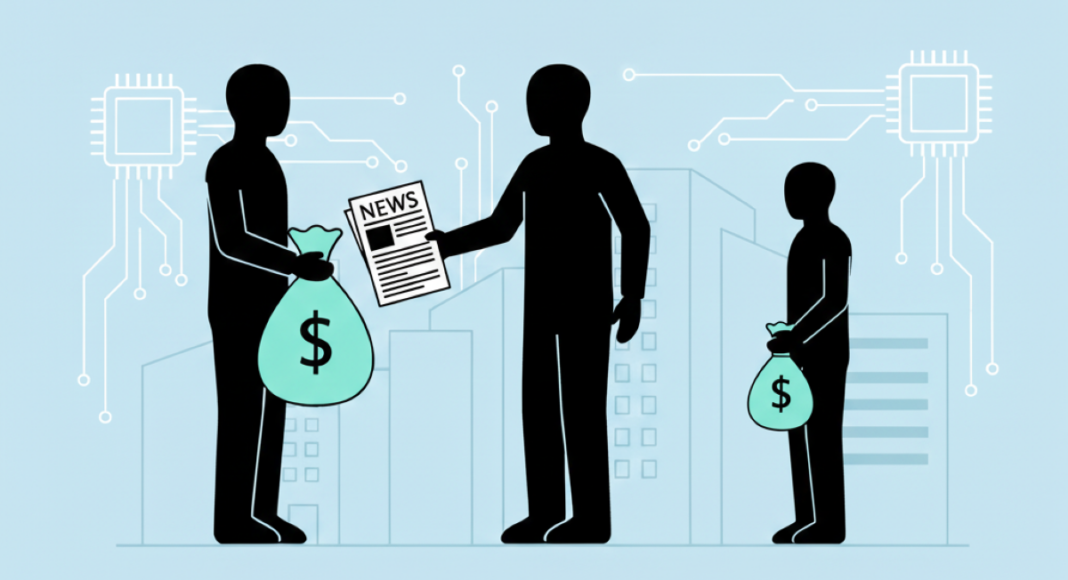Large AI firms like OpenAI and Amazon are licensing content to train their models that they might otherwise have been able to access for free under the fair use doctrine. Mark A. Lemley and Jacob Noti-Victor write that this behavior may constitute anticompetitive acquiescence—where large firms agree to license content they don’t have to in order to raise rivals’ costs.
Editor’s Note: This article is part of a symposium that examines the competitive risks posed by artificial intelligence content licensing agreements—mechanisms that on the surface appear to balance copyright protection with innovation. How might these deals compel us to rethink the relationship between copyright, data protection, innovation, and competition in the age of AI? How can we seek to uphold all four, while recognizing the inevitable tradeoffs involved? You can read the article from Mark Lemley and Jacob Noti-Victor (writing together), Matthew Sag, Christian Peukert, and Kristelia García here as they are published.
Sometimes, in law, you can win by giving up: agreeing to an adverse outcome when you could have gotten a better result from the courts or agencies. This practice turns out to be surprisingly common in a range of different circumstances, as we discuss in our larger paper. A prime example involves generative artificial intelligence companies who choose to license data from content producers like newspapers to train their artificial intelligence models, even when they could likely access much of the content for free under copyright’s fair use doctrine. Nonetheless, they are busy signing licensing deals for training data that may undermine that fair use argument. This may reflect a strategy we call anticompetitive acquiescence, where incumbent firms (here, large AI firms) establish precedents for licensing content they could use for free to raise costs for smaller rivals and potentially keep out new entrants.
The current state of fair use copyright and generative AI content licensing
AI companies are engaged in more than 40 pending lawsuits over the legality of how they train their large language models (LLMs) on copyrighted material. It is fair to say that those suits represent an existential threat to generative AI. An LLM might train on billions or even tens of billions of works; stable diffusion models train on roughly two billion images. If each of those works was registered with the Copyright Office before the infringement began and was found to have been infringed upon (an outcome we view as essentially impossible given the much smaller number of registrations granted by the Copyright Office), even the minimum statutory damages of $750 to $150,000 per work infringed could run into trillions of dollars for these AI companies.
Furthermore, if AI companies are proscribed from training their LLMs on copyrighted material, they would likely have to throw away their models and start from scratch. And training a text model only on works made before 1929, or the few modern works that are in the public domain, is impractical (there is a such a training dataset, called Common Corpus, though it includes open sources as well as public domain works and doesn’t work well across all domains). So winning these cases is a big deal for AI companies.
Because there is no dispute that the companies make internal copies of billions of works during training, whether AI companies will win these cases turns on copyright’s fair use doctrine. And whether they will prevail on fair use depends critically upon—among other factors—the market effect of the infringement.
A plaintiff cannot show market effect by merely demonstrating that the defendant competes with the plaintiff. Market effect in fair use normally means that the defendant’s infringing work takes sales away from the plaintiff’s copyrighted work. That isn’t generally true in the generative AI copyright cases, because while AIs are trained on copyrighted works, they rarely generate output that is substantially similar to a copyrighted input.
While traditional market effect analysis focused on lost sales of the copyrighted work, courts increasingly allow plaintiffs to bootstrap a second theory of market harm by showing that they would have been paid licensing fees for the work, provided there is an established or developing market for such licensing. Whether training an AI is legal therefore depends in significant part on whether there is an existing market for licensing copyrighted works for use in AI training. There was no such market when plaintiffs began filing suits in 2022, and in part for that reason AI companies have prevailed on the fair use defense in the two cases to resolve that issue so far.
But remarkably, the very companies defending those suits—the ones whose victory depends on showing that there is no licensing market—are busy signing licensing deals with copyright owners in which they pay to license AI training data. Many of these deals are confidential, but they are happening, and some are even public. For example, Amazon recently announced a major licensing agreement with The New York Times. These aren’t settlements of existing lawsuits; they are deals with copyright owners who have not sued them. AI firms are creating the very licensing market that may doom their fair use defense.
Why would a company undermine its own high-profile, bet-the-company case? Perhaps they are just avoiding a lawsuit with uncertain results by licensing content in advance. But that can’t be the whole explanation. The same companies are vigorously fighting dozens of cases with potentially much greater damages exposure even as they are licensing content from certain copyright owners. It doesn’t make a lot of sense to undermine the existing cases, which they aren’t settling, by taking licenses to small subsets of the content the AI needs to train.
In these cases and many more we discuss in our larger paper, presumably rational market actors are imposing costs on themselves. They are paying money to settle cases they are likely to win, foregoing business opportunities the law allows them, or willingly subjecting themselves to government regulation they could have avoided. Why?
Anticompetitive acquiescence
We think one answer to this puzzle is that establishing a licensing market affects not just the company that signs the deal but everyone else as well. If OpenAI sets a precedent of paying news outlets for training data, for instance, later courts may conclude that everyone has to pay them, because there is an established market for licensing that data for training. The practice of licensing changes the law itself, making once-fair uses unfair. OpenAI may pay more than it had to if it had won a very broad fair use ruling, but it will likely pay less than other companies who are now faced with an established licensing market and must pay for all content from the outset. More importantly, setting the precedent that you have to pay to license will make it much harder for small new entrants to develop and train their own AIs. OpenAI and a few other big players trained without having to pay, but anyone who follows after them will either have to pay up front or risk their own fair use defense—an argument less likely to persuade courts in the face of growing evidence of licensing. And well-funded companies like OpenAI, Google, and Meta can afford ongoing license fees much more easily than the startups that would otherwise compete with them.
We call this phenomenon “anticompetitive acquiescence.” Companies acquiesce in lawsuits, collusive settlements, licensing, or regulation as a way to raise their rivals’ costs. They suffer the costs, but they may still come out ahead if their competitors suffer more—or, even better (from their perspective), if potential competitors never enter the market at all. Even if they don’t raise rivals’ costs directly, raising rivals’ risk can also impose competitive harm.
Anticompetitive acquiescence has evaded scrutiny because it’s hard to detect and even harder to combat. Settlements and license terms are generally confidential, and courts are reluctant to peek behind the curtain to evaluate those settlements. And busy district judges like it when cases settle, so they are reluctant to question anything the parties agree to that gets a case off their docket.
These licenses are problematic because, unlike most settlements, they affect third parties. They set a bad precedent, making it more likely that future courts will reject a fair use claim because they will look to the prior settlement as evidence of the existence of a licensing market. Something similar happened in the case of music streaming: after incumbent streaming services failed to object to paying arguably duplicative mechanical royalties for almost a decade, Congress found it uncontroversial to finally establish, in the Music Modernization Act, that these payments are mandatory.
The problem is more complicated than just rent-seeking or a bad-faith grab for market power. The fair use of training data is a genuine area of uncertainty. Resolving doctrinal or regulatory uncertainty can sometimes be desirable for parties even if it means agreeing to an outcome they don’t want. So it is hard to attribute anticompetitive intent to the licensing deals even if they may have anticompetitive effects. An acquiescing party’s calculation may be influenced by the chance to disadvantage its competitors even if it might have settled the case anyway. Hurting competitors might be an added benefit to a settlement that would have happened on the same terms without that harm. But it might also affect the price of the settlement.
The upshot of all of this is that anticompetitive acquiescence is complicated. Parties may have good reasons to compromise, but they may also use those settlements to explicitly or implicitly harm competition. This complexity is one of the main reasons that many examples of anticompetitive acquiescence seem to evade scrutiny from scholars, judges, and policymakers.
Overcoming anticompetitive acquiescence
If the goal is to reduce the risk of anticompetitive acquiescence while still allowing breathing room for litigants and companies to resolve legal battles, we can’t simply prevent settlements altogether. We think the best approach is to (1) create procedural mechanisms to identify problematic acquiescence and head it off and (2) reduce the impact of acquiescence on the law applied to third parties.
Mechanisms to curtail anticompetitive acquiescence
Courts must begin by scrutinizing settlements for anticompetitive effect. This needn’t be much of a burden in most cases. It is settlements between actual and potential competitors and settlements in intellectual property cases that present the most significant competitive risks. Right now, courts often have no role at all in reviewing a settlement. And even when they do, it is common for busy judges to simply approve whatever the parties put in front of them. That’s a problem where those settlements affect third parties. Courts and regulatory adjudicators shouldn’t accept a deal simply because the parties sign on to it if the deal is likely to affect non-parties and the public interest. They should scrutinize the deal for anticompetitive risks.
Fortunately, there are several useful models to work from. Courts already scrutinize class action settlements for fairness to absent class members, for instance. Similarly, courts evaluate antitrust and other regulatory consent decrees to ensure they are consonant with the public interest. And some courts have rejected settlements of antitrust cases that seem to entrench rather than undermine the monopoly.
This model can be applied beyond class action settlements and consent decrees. The key is for courts to consider not just the interests of the settling parties but the interests of absent parties and the public as a whole. If after initial review a judge sees potential risks, they could open the settlement for comment by interested parties. If incumbent AI companies attempt to settle any of their ongoing infringement claims by establishing a licensing market, this scrutiny would be particularly important. A judge would need to ask whether such a deal might potentially harm the business activities of other firms, or the public’s interest in access to innovative technologies. Something similar happened years ago in the case of the Google Books class action litigation, which involved Google’s scanning of copyrighted books to create a search tool. Citing several public interest concerns, including potential harms to competition, the district court rejected the settlement, enabling the case to proceed to what was ultimately a fair use win for Google.
Mitigating the effects of anticompetitive acquiescence
Of course, private licensing deals that happen outside the context of existing litigation aren’t subject to court approval. So a second important step to reduce the anticompetitive effects of acquiescence involves not trying to scrutinize the agreements themselves, but rather reducing the effects those agreements have on future cases, and on law in general.
This is particularly important in the generative AI fair use context. As we noted above, when AI companies agree to pay to license content they can legally use for free, they create a licensing market for those uses that harms current and potential future competitors. It will be essential for judges to weed out licensing deals that might have emerged from anticompetitive acquiescence when determining whether generative AI training is fair use. We think this is doable if judges are attuned to the problem. Despite the frequent invocation that fair use must account for existing licensing markets, this is not a foregone conclusion. In fact, numerous commentators (including one of us) have criticized this reasoning as circular: if a use becomes less fair based on the existence of actual licensing arrangements, then fair use can no longer be used to favor desirable uses; rather, it becomes entirely tethered to whether or not transaction costs preclude licensing. At times, the Second Circuit Court of Appeals has seemed to accept this critique, noting, for example, that a “copyright holder cannot prevent others from entering fair use markets merely ‘by developing or licensing a market for parody, news reporting, educational or other transformative uses of its own creative work.’”
The ultimate Google Books fair use decision is illustrative. That decision happened after the court rejected a settlement that would have established a licensing scheme for scanned books. The rejected settlement would seem to have suggested that a licensing market for eBook search was feasible (even if not yet existent), but the Second Circuit still found that Google’s activities were fair use, noting that the existence of actual or hypothetical licensing markets did not disturb this finding. Essentially, the court found that the Google Books search tool was both socially valuable and fundamentally different from copyright owners’ traditional distribution and licensing uses. Such a transformative use was simply not a one that should require compensation, even if licensors were willing to pay.
The courts can and should do something similar in the generative AI fair use cases. These cases ultimately come down to an issue similar to the one presented in Google Books: whether utilizing copyrighted works in order to generate information (rather than reproduce protectable expression) is transformative and thus weighs in favor of fair use. Relying on Google Books and related cases, the courts could find that even if certain AI companies are willing to license training data from copyright owners, that does not mean they have to. If the use is deemed to be highly transformative, then any existing licensing deals should have little bearing on the ultimate fair use finding. And such a fair use finding could, if properly structured, create a global precedent allowing generative AI companies to use training data for free, reducing (but not eliminating) the incentive for AI companies to enter into licensing deals in order to raise costs for their smaller rivals.
Authors’ note: Mark A. Lemley is the William H. Neukom Professor, Stanford Law School; of counsel, Lex Lumina LLP. Jacob Noti-Victor is Professor of Law, Benjamin Cardozo School of Law, Yeshiva University. © 2025 Mark A. Lemley & Jacob Noti-Victor. This article is adapted from Mark A. Lemley and Jacob Noti-Victor, “Anticompetitive Acquiescence,” forthcoming in the Florida Law Review.
Authors’ Disclosure: Mark A. Lemley represents defendants (Anthropic and Stability AI) in some of the pending cases mentioned in this article and has in the past represented Meta in other pending cases. Jacob Noti-Victor reports no conflicts of interest. The opinions expressed in this article belong solely to the authors. You can read ProMarket’s disclosure policy here.
Articles represent the opinions of their writers, not necessarily those of the University of Chicago, the Booth School of Business, or its faculty.
Subscribe here for ProMarket‘s weekly newsletter, Special Interest, to stay up to date on ProMarket‘s coverage of the political economy and other content from the Stigler Center.






